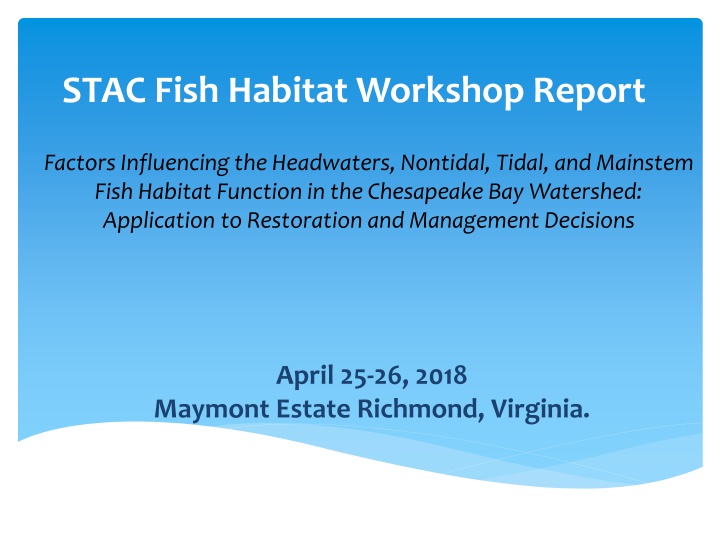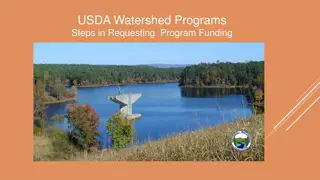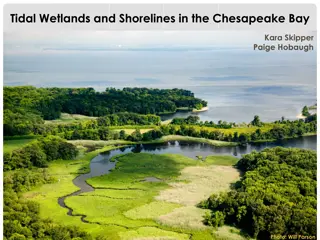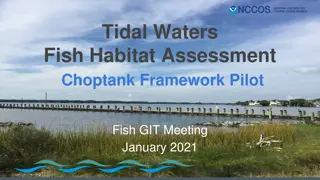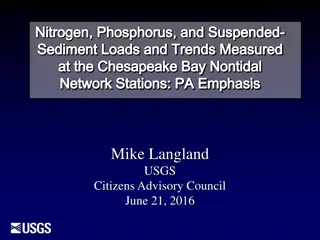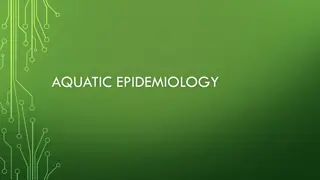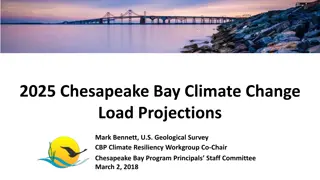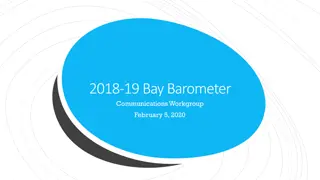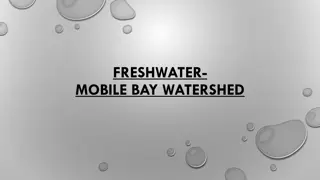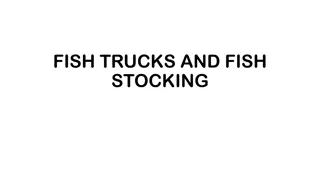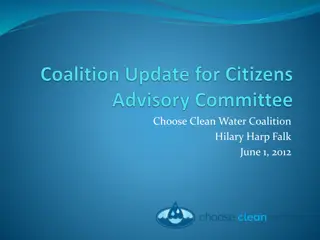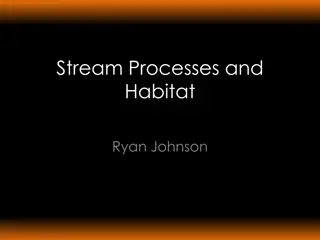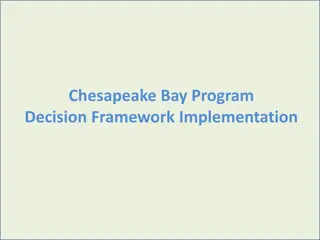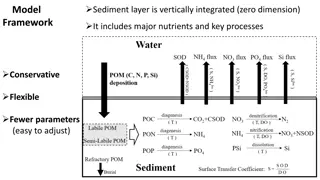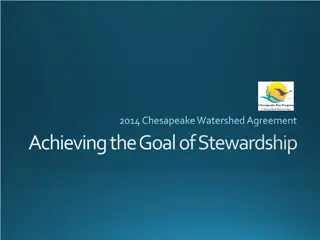Factors Influencing Fish Habitat in Chesapeake Bay Watershed Workshop Report
This workshop report delves into the factors affecting fish habitat function in the Chesapeake Bay Watershed, focusing on headwaters, nontidal, tidal, and mainstem areas. It outlines the workshop process, assessment frameworks, and user needs to support restoration and management decisions. The report highlights the collaborative efforts of the steering committee and the importance of integrating scientific data for effective decision-making in fish habitat management and restoration.
Download Presentation

Please find below an Image/Link to download the presentation.
The content on the website is provided AS IS for your information and personal use only. It may not be sold, licensed, or shared on other websites without obtaining consent from the author.If you encounter any issues during the download, it is possible that the publisher has removed the file from their server.
You are allowed to download the files provided on this website for personal or commercial use, subject to the condition that they are used lawfully. All files are the property of their respective owners.
The content on the website is provided AS IS for your information and personal use only. It may not be sold, licensed, or shared on other websites without obtaining consent from the author.
E N D
Presentation Transcript
STAC Fish Habitat Workshop Report Factors Influencing the Headwaters, Nontidal, Tidal, and Mainstem Fish Habitat Function in the Chesapeake Bay Watershed: Application to Restoration and Management Decisions April 25-26, 2018 Maymont Estate Richmond, Virginia.
Workshop Steering Committee Gina Hunt Coordinator (MDNR/ FHAT) Mark Monaco (NOAA / STAC) Margaret McGinty (MDNR / FHAT) Tom O Connell (USGS) Donna Bilkovic (VIMS/STAC/FHAT) Bruce Vogt (NOAA/SFGIT/ FHAT) Peter Tango (USGS/STAR) Rich Starr (Ecosystem Planning & Restoration/SHWG) Neely Law (SHWG) Tom Ihde (STAC/ FHAT) Mary Gattis (Alliance for the Chesapeake Bay /LGAC)
Outline Workshop Process and Framework Utility of a Chesapeake Bay Watershed Regional Fish Habitat Assessment National Fish Habitat Assessment What can you do with an assessment? Results Recommendations Next Steps
Fish Habitat Workshop Assessment Framework Objective: To identify the necessary information and analytical approaches to assess the condition and vulnerability of fish habitat in the Chesapeake Bay Watershed. Guiding Principles: Scale must support planning and management decisions Based on best available science, data, and analytical approaches. Designed to integrate or compliment with other tools
Regional Fish Habitat Assessment User Needs A guiding principal for the assessment framework is that it should support planning and management decisions. Therefore, a user-needs questionnaire was developed to determine what land use and restoration planners, and habitat and fish managers need in a fish habitat assessment.
Questionnaire Methods Survey Monkey all online. 40% open rate Nineteen Questions 148 individuals responded to the questionnaire. 41% work in local government. More than any other sector.
Questionnaire Results Responses from all jurisdictions in the watershed 6% D.C. 12% 10% Delaware Maryland 22% New York 23% Pennsylvania Virginia 7% 20% West Virginia
Questionnaire Results Good News! 70% indicated that they would use a regional habitat assessment to prioritize potential sites for restoration/conservation. But there are many existing spatial tools! Additional responses indicated it would need to complement their current process or tools.
Questionnaire Results What map scale is most appropriate so you could use a regional Habitat Assessment to improve your work? Majority requested the smallest scale offered: less than 1:24,000. Others suggested the HUC 12 scale or smaller and the ability to switch from a Google Earth to Topo map scale. Ability to move back and forth based on resolution of available data- Hierarchical assessment
Questionnaire Conclusions The assessment will not be the primary process for choosing a restoration or conservation area; but they will use it. In order to be meaningful, it will need to work well with their existing tools and processes, provide resolution at a local scale and provide information that has been otherwise unavailable or scattered in its availability.
Fish Habitat Workshop Assessment Framework Objective: To identify the necessary information and analytical approaches to assess the condition and vulnerability of fish habitat in the Chesapeake Bay Watershed. Guiding Principles: Scale must support planning and management decisions Based on best available science, data, and analytical approaches. Designed to integrate or compliment with other tools
National Fish Habitat Partnership Produce Status of Fish Habitats in the United States report every 5 years http://assessment.fishhabitat.org/ Three Products for 2015 1. Inland Stream Assessment 2. National Estuary Assessment 3. Regional Estuary Assessment-Gulf of Mexico
What Do the Assessments TellUs? Status Which areas are most affected by anthropogenic stress? Areaswith the worst relative condition could be considered high priority for restoration may be targets for conservation. Finer-scale assessments could help guide management actions, and specific habitat management objectives to help recover or improve productivity of fish populations. Can identify where high quality areas are that
What Do the Assessments TellUs? Gives a national picture of fish habitat condition; landscape-scale results are seamless across the US. But won't be very good at local scale using 1:100K data. And missing some significant regional data because it is not nationally available. What do we have that it is missing???
Thank Goodness for USGS and NOAA Partners!!! A team of USGS and NOAA scientists determined the availability of these data for the Chesapeake Bay watershed and compiled the relevant metadata. Objective- Identify data specific to the Chesapeake Bay watershed that were either not used in the 2015 National Fish Habitat Partnership (NFHP) Assessment or that were newly available at a finer spatial scale.
A summary of variables identified from the compilation effort compared to the National Fish Habitat Partnership Assessments separated by Factor Grouping Factors # Variables # Variables NFHP Inland # Variables NFHP Estuary Watershed 18 0 0 Pollution 38 3 1 Dams Mines Water Use Human Urban 12 53 7 5 34 2 4 5 1 6 1 1 1 1 7 Ag Natural Nutrient 26 86 29 2 3 3 2 13 0 Water Quality Climate Habitat 19 20 38 0 2 0 1 0 0 Biological (Response and Predictor) 46 11 0 Miscellaneous 10 0 0 Total = 15 441 31 28
Fish Habitat Workshop Assessment Framework Objective: To identify the necessary information and analytical approaches to assess the condition and vulnerability of fish habitat in the Chesapeake Bay Watershed. Guiding Principles: Scale must support planning and management decisions Based on best available science, data, and analytical approaches. Designed to integrate or compliment with other tools DAY 1 Identify scale needed to drive action at relevant management levels Determine criteria for selection and ranking of variables Identify the variables (stressors and conditions) most influencing habitat condition and vulnerability. DAY 2 Prioritize the variables (stressors and conditions) most influencing habitat condition and vulnerability. Identify information gaps Recommendations
Workshop Results Determine Scale and Criteria to Rank Variables List aggregate variable/stressors for each factor Criteria 2: Mitigation Potential 4 4 4 4 4 4 6 2 4 4 4 2 2 2 2 2 4 2 2 0 0 Criteria 1: Severity 6 6 6 6 6 6 6 6 6 6 6 6 6 6 6 6 6 6 6 6 6 Criteria 3: Certainty Factor 6 6 6 6 6 6 6 6 6 6 6 6 6 6 6 6 6 6 6 6 6 Habitat TidalFresh Nutrients TidalFresh Toxins TidalSalt TidalSalt TidalSalt TidalSalt TidalFresh Fishing activities TidalFresh Invasive species TidalSalt loss of feeding habitat TidalSalt loss of forage TidalSalt HABs TidalSalt trophic effects TidalSalt invasive species TidalFresh Temperature TidalSalt Water temp TidalSalt SLR WarmNontidal stormwater runoff WarmNontidal fragmentation / deforestation WarmNontidal impervious surface WarmNontidal population density WarmNontidal housing density Fishing / boating activities Land use change (shoreline, etc.) Scale: 1:24,000 Agriculture Agriculture Agriculture Agriculture Agriculture Agriculture Biological Biological Biological Biological Biological Biological Biological Climate Climate Climate Human Human Human Human Human nutrients runoff sedimentation Land use Three Criteria selected: Severity Mitigation Potential Certainty Ranked- assigned a numerical score (2, 4, or 6) to each criteria TidalFresh 6 6 6 Human TidalFresh 6 4 6 Human
Workshop Results Identify the Variables Most Influencing Habitat From the list of 441 variables: 87 variables were identified from the combined habitat groups as likely to have a significant impact on fish habitat in the Chesapeake Bay watershed (determined as a severity and certainty score of 6). 54 unique variables identified as having a significant impact on fish habitat. Number of Unique Variables Identified with High Severity and Certainty 7* Habitat Type Total Number of Selected Variables Headwaters 23* 15 Large Nontidal Rivers 108 31 Tidal Freshwater 83 34 Tidal Saltwater 66
Workshop Results Variables that were Identified as Significant by Multiple Habitat Types Factor Stressor/Variable Habitat 4 Habitats Large Nontidal Rivers , Tidal Salt, Headwaters, Tidal Fresh Large Nontidal Rivers, Tidal Salt, Tidal Fresh, Headwaters Agriculture, Nutrients Nutrients Urban, Human Impervious Surface 3 Habitats Climate, Habitat, Pollution, Water Quality Agriculture, Urban, Pollution Urban, Human Agriculture, Human Agriculture, Habitat Human Water Temperature Sedimentation Stormwater discharge/runoff Land use Erosion population density/change Tidal Salt, Tidal Fresh, Headwaters Large Nontidal Rivers , Tidal Salt, Headwaters Large Nontidal Rivers , Tidal Salt, Headwaters Tidal Salt, Tidal Fresh, Headwaters Large Nontidal Rivers , Tidal Fresh, Headwaters Large Nontidal Rivers , Tidal Fresh, Headwaters 2 Habitats Habitat Biological Urban, Human Urban, Natural SAV Loss Invasive species Habitat loss Wetlands loss Tidal Salt, Tidal Fresh Tidal Salt, Tidal Fresh, Tidal Salt, Tidal Fresh, Tidal Salt, Tidal Fresh,
Identify Information Gaps Each Habitat type answered the following questions: What variables are we missing or underrepresented with data per habitat type (gaps)? What additional stressors should we recommend need study/monitoring? What are the implications on the assessment tool of not having without having the information? Research recommendations?
Recommendations Develop Pilot Assessment- Continue gathering data sets on key stressors along with biological data and evaluating the scale of applicability. Select pilot areas and test various biological response metrics to determine which measures are most sensitive to stressors and to validate approach and utility. Incorporate Adaptability- an assessment should be built in a way that can incorporate additional stressors as science evolves.
Recommendations Develop the Assessment at the finest scale possible- A fine spatial scale (1:24,000 or finer) is recommended for planning, management, restoration, or mitigation of fish habitats. Participants recognized a hierarchical approach may be necessary because not all data are available Bay-wide at this resolution.
Recommendations Prioritize Research Needs- Identified numerous research needs. All groups suggested researching stressors that were ranked as low certainty and expected high severity. Conduct data mining exercise to fill data gaps- Datasets were identified, but data were lacking for some habitat types. Additional data needs are listed under each habitat type. Where data gaps persist, research should be prioritized.
Recommendations Establish a Community of Practice- a group of people among those utilizing and developing fish habitat assessment tools to facilitate the transfer of knowledge on lessons learned. Identify a person as an Assessment Coordinator- Identify a person to lead the workshop recommendations and build upon the enhanced collaborations from this workshop. A coordinator would be instrumental in making the connections with this Chesapeake Bay habitat assessment effort and the larger Northeast habitat assessment.
Next Steps We incorporated the recommendations and the new stressor information into Version 2 of the Fish Habitat Management Strategy. Approved by the board yesterday!
Next Steps A post-workshop project proposal was selected for Chesapeake Bay Program GIT funding. Funds will be used to secure a contractor for one year to continue building on the STAC workshop data inventory with biological data and analysis of the data for use in the pilot assessments, and potential regional assessment. Collaboration with NOAA and USGS partners will continue with this project.
Regional Fish Habitat Assessment Project Technical Project Advisory Committee- Steve Faulkner (USGS) Bruce Vogt (NOAA, Fish GIT Coordinator) Suzanne Skelley (NOAA, Director Oxford Cooperative Lab) A.K. Leight (NOAA) Gina Hunt (MD. DNR, Fish Habitat Team Coordinator) Additional folks added for information sharing at certain meetings. (ie. Scott Phillips (USGS), ACFHP, MAFMC). Coordinating with other fish habitat assessments: National Assessment, Southeast Regional Assessment (NC to FL), Northeast Assessment. Not the same stressor data focus. Fish Habitat Action Team will serve in non-technical oversight role; coordination with user-needs.
Project Timeline 2018 2019 2020 2021 Calendar Year Jan-Mar Apr-June July-Sept Oct-Dec Jan-Mar Apr-June July-Sept Oct-Dec Jan-Mar Apr-June Jul-Sept Oct- Dec Project timeline illustrates a systematic approach to a regional fish habitat assessment and contribution of GIT funding. Workshop Report Completed and Approved Conduct Fish Habitat Workshop to identify the necessary information and analytical approaches for fish habitat assessment. Data inventory of 441 stressor variables influencing fish habitat compiled for Workshop Development of GIT funding proposal to complete data inventory Partners Collaborative Work to Precede Award Brief Fish and Habitat GITs Develop Preliminary conceptual model/pathway to CB Assessment for all 4 habitat types Contractor working to discover and assess biological data and remaining environmental data for tidal waters. (outreach to assessment users) and coordination opportunities. Metadata Analysis Look for communication Work of Contractor We are Here! Work to inform discussion of Pilot Assessments Seek feedback on database and metadata results Continue to engage with GITs, assess needs of stakeholders, Advisory committee, and collaborate and evaluate approach of upcoming assessments (N.E Regional Assessment) Develop recommendations for conducting assessments and select pilot assessment areas. Collaborative Team Work Conduct Pilot Assessments Seek funding and expand partnership to conduct watershed fish habitat assessment
Project Timeline 2018 2019 2018 Oct-Dec 2020 2019 2021 2020 2021 Calendar Year Calendar Year Jan-Mar Jan-Mar Apr-June July-Sept Oct-Dec Jan-Mar Apr-June July-Sept Apr-June July-Sept Jan-Mar Oct-Dec Apr-June Jan-Mar Apr-June Jul-Sept July-Sept Oct- Dec Oct-Dec Jan-Mar Apr-June Jul-Sept Oct- Dec Workshop Report Completed and Approved Workshop Report Completed and Approved Conduct Fish Habitat Workshop to identify the necessary information and analytical approaches for fish habitat assessment. Conduct Fish Habitat Workshop to identify the necessary information and analytical approaches for fish habitat assessment. Data inventory of 441 stressor variables influencing fish habitat compiled for Workshop Data inventory of 441 stressor variables influencing fish habitat compiled for Workshop Development of GIT funding proposal to complete data inventory Development of GIT funding proposal to complete data inventory Partners Collaborative Work to Precede Award Partners Collaborative Work to Precede Award Brief Fish and Habitat GITs Brief Fish and Habitat GITs Develop Preliminary conceptual model/pathway to CB Assessment for all 4 habitat types Develop Preliminary conceptual model/pathway to CB Assessment for all 4 habitat types Contractor working to discover and assess biological data and remaining environmental data for tidal waters. Contractor working to discover and assess biological data and remaining environmental data for tidal waters. Metadata Analysis Metadata Analysis Work of Contractor Work of Contractor Work to inform discussion of Pilot Assessments Work to inform discussion of Pilot Assessments Seek feedback on database and metadata results Seek feedback on database and metadata results Continue to engage with GITs, assess needs of stakeholders, Advisory committee, and collaborate and evaluate approach of upcoming assessments (N.E Regional Assessment) Continue to engage with GITs, assess needs of stakeholders, Advisory committee, and collaborate and evaluate approach of upcoming assessments (N.E Regional Assessment) Develop recommendations for conducting assessments and select pilot assessment areas. Develop recommendations for conducting assessments and select pilot assessment areas. Collaborative Team Work Collaborative Team Work Conduct Pilot Assessments Conduct Pilot Assessments Seek funding and expand partnership to conduct watershed fish habitat assessment Seek funding and expand partnership to conduct watershed fish habitat assessment
